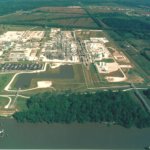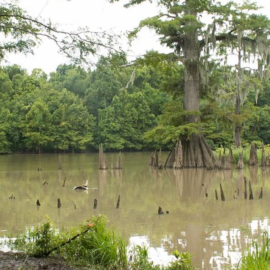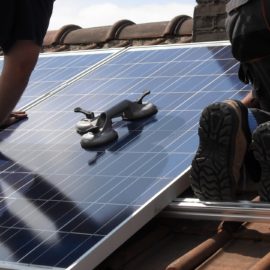
Judge, tell Denka to clean up their mess and especially their emissions.
The Environmental Protection Agency on Tuesday asked a federal judge in New Orleans to order Denka Performance Elastomers to take immediate action to “eliminate the imminent and substantial endangerment posed by chloroprene emissions” to residents near the LaPlace plant, the only one in the nation producing the likely cancer-causing chemical. In announcing the legal action, EPA Administrator Michael Regan referred to his 2021 visit to Louisiana to highlight environmental justice issues, a trip that included a stop in St. John the Baptist Parish. “I pledged to the community that EPA would take strong action to protect the health and safety of families from harmful chloroprene pollution from the Denka facility,” he said in a news release. “The company has not moved far enough or fast enough to reduce emissions or ensure the safety of the surrounding community. This action is not the first step we have taken to reduce risks to the people living in Saint John the Baptist Parish, and it will not be the last.”
nola.,com

The chemical is used in making wet suits as well as other flexible items.
Chloroprene is an ingredient manufactured at the facility as part of its production of neoprene, a synthetic rubber material used in gloves and diving wetsuits. “The concentrations of airborne chloroprene in the communities surrounding the facility are exposing thousands of people living there, including children younger than 16, to lifetime cancer risks that are multiples higher than what is typically considered acceptable by several United States regulatory agencies charged with protecting human health,” the court filing said. “And the only source of chloroprene emissions in St. John the Baptist Parish is Denka’s neoprene manufacturing operations at the facility.” Denka called the EPA’s legal action “unprecedented” and alleged it was badly flawed, adding that “data from the Louisiana Tumor Registry listed St. John cancer rates in the bottom 25 percent among Louisiana parishes in its most recent report.” It said it deviated from the usual process of handling such issues “to allege an ’emergency’ based on outdated and erroneous science the agency released over 12 years ago.” The company cited a new study of chloroprene risk that Denka sponsored and submitted to the agency in 2022 that concluded there was no increased risk. Denka cited the study in a January lawsuit filed against EPA challenging its chloroprene limits, which also argued that the agency’s risk study was criticized by some of its peer reviewers. “We believe it is critical the best available science is used to protect human health and the environment. The people of St. John the Baptist Parish deserve current and accurate scientific information regarding health risks in their community,” Denka Executive Officer and Plant Manager Jorge Lavastida said in the statement.

I don’t know who did their study or more important who paid for it. The EPA study goes back to 2010.
But, according to the filling, while Denka has significantly reduced chloroprene emissions since being ordered to do so by the state Department of Environmental Quality in January 2016, it is still emitting about 18 tons of the chemical a year. And monitors operated by both Denka and EPA in communities around the facility indicate emission levels have averaged between 0.4 and 2.9 micrograms per cubic meter since Aprill 2018, with all locations exceeding the 0.2 micrograms goal. According to U.S. Census data, between 15,000 and 17,000 people live within 2.5 miles of the facility, and more than 20% are under 18. Of those, 800 to 1,000 are children under 5. The filing also pointed out that Fifth Ward Elementary School, attended by more than 300 children, is a half-mile from Denka’s center and East St. John High School, with 1,200 students, is 1.5 miles north of Denka. The filing by the U.S. Justice Department on behalf of the EPA also asks that DuPont Specialty Products USA LLC, which sold the facility to Denka in 2015, but still owns the land on which it is located, be ordered to authorize construction and other measures by Denka that might be needed to reduce emissions. Denka’s lease with DuPont requires DuPont’s permission for new construction projects.
How Denka does the improvements is up to them.
In the filing, EPA does not say how it expects Denka to reduce emissions to the required level, when that reduction must be achieved, or whether the court should require Denka to shut down until it is able to meet the emission reduction requirements. State Department of Environmental Quality spokesperson Greg Langley said “we have worked to achieve emissions reductions at this facility for five years with tangible success. LDEQ is always looking for more emissions reductions and welcomes any assistance in that effort.” In its January suit against EPA, Denka also pointed out that it had spent $35 million on improvements at the plant, including construction of a special incinerator, and reduced emissions by about 85%, and that further reductions would be difficult to achieve. In January, Louisiana’s two U.S. senators asked EPA to reconsider its chloroprene rules. Sens. Bill Cassidy and John Kennedy, both Republican, said “an update of the cancer risk assessment for chlorooprene should be a national priority,” and echoed Denka’s contention that EPA’s rules are based on flawed science. In December, Denka entered into a consent agreement with EPA over violations of hazardous waste rules related to the handling of chloroprene wastes identified during EPA inspections in April and May. The company agreed to dispose of the waste at properly licensed disposal facilities, and to assure employees handling the wastes were wearing the proper protective equipment.
The EPA action was lauded by the environmental community.
Monday’s EPA action was praised by environmental activists. “The families of St. John the Baptist Parish have been waiting a long time for EPA to protect their health from cancer-causing chemicals emitted by DuPont/Denka into their community,” said Darryl Malek-Wiley, a New Orleans based representative of the Sierra Club. “EPA should have taken action in 2016 when they first notified Reserve, Louisiana families about the elevated levels of cancer-causing chemicals. Thankfully, the EPA appears to have stepped in where the Louisiana Department of Environmental Quality was unwilling or unable, neither of which is satisfactory for Louisiana families.” “The families of St. John the Baptist Parish have been waiting a long time for EPA to protect their health from cancer-causing chemicals emitted by DuPont/Denka into their community,” said Darryl Malek-Wiley, a New Orleans based representative of the Sierra Club. “EPA should have taken action in 2016 when they first notified Reserve, Louisiana families about the elevated levels of cancer-causing chemicals. Thankfully, the EPA appears to have stepped in where the Louisiana Department of Environmental Quality was unwilling or unable, neither of which is satisfactory for Louisiana families.” Earthjustice represented the Concerned Citizens of St. John and Sierra Club in filing complaints with EPA about emissions from Denka and Formosa Plastics in 2021. That led to EPA beginning an investigation into whether DEQ and the state Department of Health discriminated against Black residents in handling permitting decisions for the two facilities. That investigation is not yet complete.
Our pack with the devil sometimes comes back on the devil and this is a case. You want to be her – do it responsibly.



